Summary
Most (>90%)Escherichia coli strains isolated from children with acute non-obstructive pyelonephritis exhibit a specific type of filamentous protein appendage known as P-fimbriae. These fimbriae enable the bacterium to adhere to human uroepithelial cells by the specific recognition of and binding to a particular class of glycosphingolipids correlated to the human P-blood group antigens. In this paper a new method for the rapid and reliable identification of such P-fimbriated pyelonephritogenic bacteria is described. The method is based on particles to which the minimal glycoside receptor structure recognized by P-fimbriae is attached. Mixing these receptor-containing particles with P-fimbriated bacteria results in a strong and immediate agglutination reaction. The specificity and sensitivity of this new particle agglutination test proved to be superior to the haemagglutination assay previously used.
Zusammenfassung
Die meisten (mehr als 90%) der von Kindern mit akuter, nicht obstruktiver Pyelonephritis isoliertenEscherichia coli-Stämme weisen einen spezifischen Typ von filamentösen Protein-Anhangsstrukturen auf, die als P-Fimbrien bekannt sind. Diese Fimbrien befähigen das Bakterium, sich an menschliche Urothelien anzuheften. Dabei erkennen die Fimbrien spezifisch Glykosphingolipide einer bestimmten Klasse, die mit den menschlichen P-Blutgruppenantigenen in Beziehung stehen, und binden sich an sie. In der vorliegenden Arbeit wird eine neue Methode zur raschen und sicheren Identifizierung von solchen P-Fimbrien-tragenden pyelonephritogenen Bakterien beschrieben. Die Methode basiert darauf, daß die kleinsten, von P-Fimbrien erkennbaren Strukturen des Glykosid-Rezeptors an Partikel gebunden werden. Die Mischung dieser Rezeptor-tragenden Partikel mit P-Fimbrien-tragenden Bakterien führt zu einer starken, sofortigen Agglutinationsreaktion. Dieser neue Partikelagglutinationstest erwies sich in Spezifität und Sensibilität als dem früher verwandten Hämagglutinationstest überlegen.
Similar content being viewed by others
Literature
Svanborg Edén, C., Hanson, L. Å., Jodal, U., Lindberg, U., Sohl Åkerlund, A. Variable adherence to normal human urinary tract epithelial cells ofEscherichia coli strains associated with various forms of urinary tract infections. Lancet II (1976) 490–492.
Svanborg Edén, C., Eriksson, B., Hanson, L. Å., Jodal, U., Kaijser, B., Lidin Janson, G., Lindberg, U., Olling, S. Adhesion to normal human uroepithelial cells ofEscherichia coli from children with various forms of urinary tract infection. J. Pediatr. 93 (1978) 398–403.
Källenius, G., Svenson, S. B., Möllby, R., Cedergren, B., Hultberg, H., Winberg, J. Structure of carbohydrate part of receptor on human uroepithelial cells for pyelonephritogenicE. coli. Lancet II (1981) 604–606.
Källenius, G., Möllby, R., Svenson, S. B., Helin, I., Hultberg, H. Cedergren, B., Winberg, J. Occurrence of P-fimbriatedEscherichia coli in urinary tract infections. Lancet II (1981) 1369–1372.
Korhonen, T., Väisänen, V., Saxén, H., Hultberg, H., Svenson, S. B.: P-antigen-recognizing fimbriae from human uropathogenicEscherichia coli strains. Submitted for publication.
Källenius, G., Möllby, R., Svenson, S. B., Winberg, J., Lundblad, A., Svensson, S., Cedergren, B. The pk antigen as receptor for the haemagglutinin of pyelonephriticEscherichia coli. FEMS Microbiol. Lett. 7 (1980) 297–302.
Källenius, G., Möllby, R., Svenson, S. B., Winberg, J., Hultberg, H. Identification of a carbohydrate receptor recognized by uropathogenicEscherichia coli. Infection 8 Suppl. 3 (1980) S 288-S 293.
Marcus, D. M., Naiki, M., Kundu, S. K. Abnormalities in the glycosphingolipid content of human pk and\(\bar p\) erythrocytes. Proc. Natl. Acad. Sci. 73 (1976) 3263–3267.
Källenius, G., Svenson, S. B., Möllby, R., Korhonen, T. K., Winberg, J., Cedergren, B., Helin, I., Hultberg, H.: Carbohydrate receptor structures recognized by uropathogenicE. coli. Scand. J. Infect. Dis. In print.
Väisänen, V., Elo, J., Tallgren, L., Siitonen, A., Mäkelä, H., Svanborg Edén, C., Källenius, G., Svenson, S. B., Hultberg, H., Korhonen, T. Mannose-resistant haemagglutination and P antigen recognition are characteristic ofE. coli causing primary pyelonephritis. Lancet II (1981) 1366–1369.
Evans, D. G., Evans, Jr. D. J., Tjoa, W. Hemagglutination of human group A erythrocytes by enterotoxigenicEscherichia coli isolated from adults with diarrhea: correlation with colonizing factor. Infect. Immun. 18 (1977) 656–667.
Smyth, C. J., Kaijser, B., Bäck, E., Faris, A., Möllby, R., Söderlind, O., Stintzing, G., Wadström, T. Occurrence of adhesins causing mannose-resistant haemagglutination of bovine erythrocytes in enterotoxigenicEscherichia coli. FEMS Microbiol. Lett. 5 (1979) 85–90.
Källenius, G., Möllby, R. Adhesion ofEscherichia coli to human periurethral cells correlated to mannose-resistant agglutination of human erythrocytes. FEMS Microbiol. Lett. 5 (1979) 295–299.
Minshew, B. H., Jorgensen, J., Swanstrum, M., Grootes-Reuvecamp, G. A., Falkow, S. Some characteristics ofEscherichia coli strains isolated from extraintestinal infections of humans. J. Infect. Dis. 137 (1978) 648–654.
Ljungh, Å., Faris, A., Wadström, T. Hemagglutination byEscherichia coli in septicemia and urinary tract infections. J. Clin. Microbiol. 10 (1979) 477–481.
Green, C. P., Thomas, V. L. Hemagglutination of human type 0 erythrocytes, hemolysin production, and serogrouping ofEscherichia coli isolates from patients with acute pyelonephritis, cystitis, and asymptomatic bacteriuria. Infect. Immun. 31 (1981) 309–315.
Hagberg, L., Jodal, U., Korhonen, T. K., Lidin-Janson, G., Lindberg, U., Svanborg Edén, C. Adhesion, hemagglutination, and virulence ofEscherichia coli causing urinary tract infections. Infect. Immun. 31 (1981) 564–570.
Author information
Authors and Affiliations
Rights and permissions
About this article
Cite this article
Svenson, S.B., Källenius, G., Möllby, R. et al. Rapid identification of P-fimbriated Escherichia coli by a receptor-specific particle agglutination test. Infection 10, 209–214 (1982). https://doi.org/10.1007/BF01666912
Received:
Issue Date:
DOI: https://doi.org/10.1007/BF01666912




